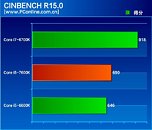Thursday, November 3rd 2016

Intel Core i5-7600K Tested, Negligible IPC Gains
Ahead of its launch, a Core i5-7600K processor (not ES) made its way to Chinese tech publication PCOnline, who wasted no time in putting it through their test-bench, taking advantage of the next-gen CPU support BIOS updates put out by several socket LGA1151 motherboard manufacturers. Based on the 14 nm "Kaby Lake" silicon, the i5-7600K succeeds the current i5-6600K, and could be positioned around the $250 price-point in Intel's product-stack. The quad-core chip features clock speeds of 3.80 GHz, with 4.20 GHz max Turbo Boost frequency, and 6 MB of L3 cache. Like all its predecessors, it lacks HyperThreading.
In its review of the Core i5-7600K, PCOnline found that the chip is about 9-10% faster than the i5-6600K, but that's mostly only due to its higher clock speeds out of the box (3.80/4.20 GHz vs. 3.50/3.90 GHz of the i5-6600K). Clock-for-clock, the i5-7600K is just about 1% faster, indicating that the "Kaby Lake" architecture offers only negligible IPC (instructions per clock) performance gains over the "Skylake" architecture. The power-draw of the CPU appears to be about the same as the i5-6600K, so there appear to be certain fab process-level improvements, given the higher clock speeds the chip is having to sustain, without a proportionate increase in power-draw. Most of the innovation appears to be centered on the integrated graphics, which is slightly faster, and has certain new features. Find more performance figures in the review link to PCOnline below.
Sources:
PCOnline.com.cn, WCCFTech
In its review of the Core i5-7600K, PCOnline found that the chip is about 9-10% faster than the i5-6600K, but that's mostly only due to its higher clock speeds out of the box (3.80/4.20 GHz vs. 3.50/3.90 GHz of the i5-6600K). Clock-for-clock, the i5-7600K is just about 1% faster, indicating that the "Kaby Lake" architecture offers only negligible IPC (instructions per clock) performance gains over the "Skylake" architecture. The power-draw of the CPU appears to be about the same as the i5-6600K, so there appear to be certain fab process-level improvements, given the higher clock speeds the chip is having to sustain, without a proportionate increase in power-draw. Most of the innovation appears to be centered on the integrated graphics, which is slightly faster, and has certain new features. Find more performance figures in the review link to PCOnline below.





116 Comments on Intel Core i5-7600K Tested, Negligible IPC Gains
If a benchmark shows a 1% edge to Kaby Lake, it's because of more aggressive boost.We have not seen a real IPC increase of 5% since Sandy Bridge. Intel always claim to have ~10% increase every iteration, but in reality that is inflated because of dedicated hardware features and similar.Cannonlake will only bring a node shrink and fixes, but no architectural overhaul. That will come in Ice Lake (~2018).
NSFW
(with a different accent though).
Nvidia also seems to have taken that note from Intel because their GPU power efficiency is amazing also.
I don't think many here care about that though.
For laptop users tho, the native h.265/AVX igpu rendering and power efficiency is a pretty good game changer.
Also, I lol at all the comments about Intel being 3 steps ahead on AMD. During the Athlon64 and Athlon X2 days, Intel were pretty far behind. Oh and when AMD acquired ATI and introduced the first iGPU, that was also a pretty big win.
The bottom line is that when you say "never", you are never right....
Kaby Lake features absolutely the same CPU core as Sky Lake. There has to be zero IPC gains.
The only performance gain in Kaby Lake is from higher frequencies (100-300MHz) and speed increases in switching from low power modes to high performance modes.
Facepalm.jpg
www.anandtech.com/show/10183/intels-tick-tock-seemingly-dead-becomes-process-architecture-optimization
Exactly the same is with the intel CPUs situation right now.
How is intel making the money, only from new devices and very few upgrades?
spend money.
However, in the DESKTOP space, where 99% of consumers exist, AMD beat intel to the punch by three years. athlon64 came out in 2003, core 2 came out in 2006.
The only reason to upgrade is to get more cores, and then you'll need to go for the E-platform (Broadwell-E).Most hardware gradually get unstable with age, symptoms usually occur when the hardware is older than 4-5 years, and many computers are replaced before they are 8 years.
With the flat-lining of desktop computer performance the past decade, consumer usually have longer upgrade cycles for desktops than in the 90s, when people upgraded because the new one was much better.
The primary revenue source for Intel is professional customer, and there business is still booming.